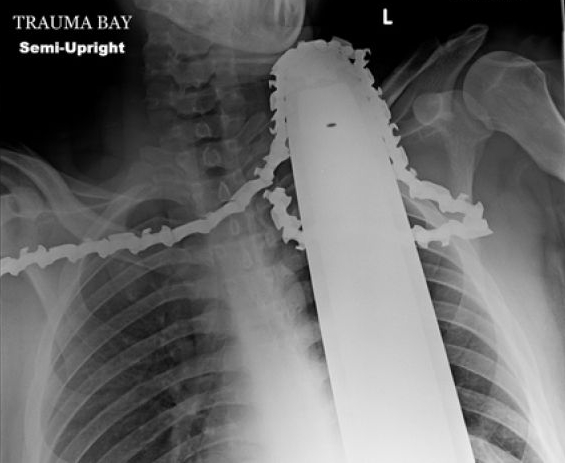A chainsaw to the neck is no routine injury – but fortunately for one Pittsburgh man, hospital trauma surgeons are prepared for the worst.
In April, 21-year-old James Valentine was working as a tree-trimmer when he was struck in the neck by a chainsaw. In a new episode of “Untold Stories of the ER,” his doctors revisited the case.
“As a trauma surgeon, we see a large collection of unusual things, including object impalement,” Dr. Christine C. Toevs, trauma ICU medical director at Allegheny General Hospital in Pittsburgh, Penn., told. “But chains to the neck with a chainsaw is still very impressive, even in the world of a trauma surgeon.”
Toevs and her team had only 10 minutes’ notice before Valentine was brought in. Her biggest concern was that he would bleed to death or that he had injured his carotid artery, which supplies the brain with blood. An injury to his esophagus would have also presented a major issue, as breathing comes first in terms of sustaining life.
Fortunately, when Valentine arrived, he was able to speak and wiggle his toes, which indicated his airway wasn’t compromised and his spinal cord wasn’t damaged. He was in some degree of shock and was appropriately scared, but he wasn’t panicking, which could have worsened the situation.
“It’d be a big issue if he panicked; we couldn’t stabilize the chainsaw, which could come out and he could bleed to death… or we could lose the airway,” Toevs said.
When the accident occurred, the chainsaw still had the motor attached, but emergency personnel were able to take it off before they reached the hospital. However, the chainsaw blade needed to remain still, so in the trauma bay, Toevs designated one person’s sole responsibility to hold the blade.
The team took a chest X-ray and found no other injuries to the chest or lungs and no blood in the chest. Valentine was taken to the operating room (OR) after a brief examination in the trauma bay.
“If there’s a problem, you want all the [surgical] resources you have,” Toevs said. “We took him to the OR and in a very controlled situation, put him to sleep, and then we pressed and got totally all set up and took out the chainsaw in a very controlled situation.”
Because there was no damage to his trachea, doctors were able to intubate him and put him on a ventilator for the surgery. Though he was losing blood, it wasn’t an alarming amount, Toevs said.
“Yes, he was losing blood because the chainsaw did injure his muscles, skin, small veins and arteries that can be tied off and don’t supply blood to the brain,” Toevs said. “It wasn’t what we call ‘firehose’ bleeding [with blood spraying uncontrollably].”
The team put Valentine to sleep, then took out the blade. Exploring the wound, they found that the blade went in about three inches in his shoulder and one inch into his neck, injuring his trapezius muscle, sternocleidomastoid muscle and other smaller muscles. But, most importantly, they found that the blade had not damaged his carotid artery.
“If it had gone a centimeter deeper, it would’ve hit. The muscle overlying the carotid was intact. Then we just explored the wound,” Toevs said. “At that point in time, it’s a huge letdown— we were preparing for the absolute worst.”
With the situation stabilized, the surgery then became routine. It took about five minutes to explore the wound to ensure nothing else was injured, then the surgeons cleaned up the blood, dirt and tree particles and closed the wound.
Valentine was admitted to the hospital overnight and began working with a physical therapist the next day. After Valentine was released from the hospital, Toevs ordered physical therapy for him to help him get his arm back to normal usage, as well as help him to move his arm above his head again.
Since Valentine is a young, healthy adult, Toevs doesn’t expect him to deal with any residual issues from the accident, and he should fully recover.
Overall, the surprisingly benign nature of the injury and the coordinated efforts of everyone involved made the procedure go smoothly, Toevs said.
“He was very blessed that he wasn’t injured more and it was also a blessing that every part went perfectly, like it was supposed to,” she said. “It was a real testimony to the EMS, the emergency department, the OR, to all the people involved… each playing a critical role to making sure he did okay.”
As for Valentine, his calmness during the perilous situation was helpful for the team— and for his recovery.
Source: fox news


